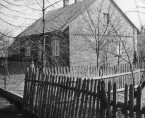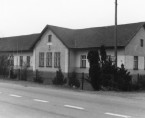Raisko
A sub-camp in the village of Rajsko (German: Raisko), most of whose residents were expelled in the spring of 1941. The vacated buildings were partially demolished and the fields taken over by camp farms. All work was done at first by men, but from 1942 there were women as well. The prisoners walked to work from Auschwitz I and Birkenau. From June 1943, the women were quartered permanently in the sub-camp and assigned to two Kommandos—gardening and plant-growing. The first Kommando grew vegetables in hothouses for the SS, tended flower beds, and worked in the nearby fields. The gardening Kommando also ran a sales outlet where SS men, their families, and civilian workers could purchase vegetables, fruit, and flowers. The women in the other Kommando worked in an experimental station where one of their most important tasks was to cultivate an Asian plant called kok saghyz under European conditions. Its roots contained caoutchouc. It was hoped to develop a strain with the highest possible content of that substance. The caoutchouc thus obtained would be used to produce rubber. The combined size of the two Kommandos grew from 250 prisoners in July 1943 to 320 the following June.
Especially in the early stages, Poles predominated among the prisoners. Aside from them, there were also Jews, Russians, Frenchwomen, Yugoslavians, and Germans. Many of the women had degrees in biology, chemistry, or agronomy. Civilian scientists, mostly from Russia, were also employed there.
There were five fenced-in barracks in the sub-camp. Prisoners lived in two of them, and the others held a workroom where kok saghyz and the extracted caoutchouc were cooked, a kitchen, and a washroom and lavatory. The hothouses, laboratory, and experimental and farm fields were near the sub-camp. Aside from the permanent workers in Raisko, male prisoners from other Kommandos were also employed there running the tool room, repairing apparatus, and doing construction work.
Because of the necessity to maintain cleanliness and precision in the research work, the conditions in the sub-camp were far superior to those in Birkenau. The women lived in heated barracks, slept in beds with sheets and blankets, washed in warm water, wore clean clothes, and ate better. On the other hand, they were closely supervised and, for example, were punished for possessing prohibited items by flogging, additional work, or assignment to the penal company (Stafkompanie). SS-Obersturmbannführer Dr. Joachim Caesar, the director of the Auschwitz farms, was in overall charge of the sub-camp. SS-Rottenführer Hermann Grell directed the work of the gardening Kommando, and SS-Obersturmführer Dr. Heinz Schattenberg directed the plant-growing Kommando. The directors of the sub-camp were SS Aufseherinnen, including Florentine Cichon, Johanna Bormann, Elizabeth Hasse, and Annelise Franz.
The sub-camp was liquidated on January 18, 1945, and the prisoners forced to join the Death March in the direction of Wodzisław Śląski, and from there by train to the Ravensbrück camp.

